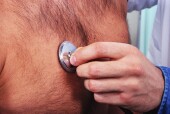- Navigating Your Midlife Crisis: Embracing New Possibilities
- City Raccoons Showing Signs of Domestication
- Mapping the Exposome: Science Broadens Focus to Environmental Disease Triggers
- One Week Less on Social Media Linked to Better Mental Health
- Your Brain Changes in Stages as You Age, Study Finds
- Some Suicide Victims Show No Typical Warning Signs, Study Finds
- ByHeart Formula Faces Lawsuits After Babies Sickened With Botulism
- Switch to Vegan Diet Could Cut Your Greenhouse Gas Emissions in Half
- Regular Bedtime Does Wonders for Blood Pressure
- Dining Alone Could Mean Worse Nutrition for Seniors
Heart Patients Without Artery Plaque Buildup Still Face Risks: Study


People who have heart disease without major plaque build-up in their coronary arteries still face a significantly increased risk for heart attack and death, a new study indicates.
The condition — called non-obstructive coronary artery disease (CAD) — damages the walls of the heart’s blood vessels, but does not decrease blood flow or cause symptoms. Because of that, it’s generally been regarded as being a low-risk condition, according to background information in the study.
Researchers analyzed data from nearly 41,000 U.S. veterans who underwent heart angiography — a test used to check for blockages in the arteries — between 2007 and 2012. They were categorized as having either normal, non-obstructive or obstructive coronary artery disease.
The more severe the disease, the greater the risk of heart attack and death within a year after undergoing angiography. This was true even among those with non-obstructive disease, who had a 28 percent to 44 percent increased risk of heart attack or death.
It’s possible that non-obstructive plaque deposits in coronary arteries can still rupture and cause heart attacks, said the researchers, who were to present their findings Wednesday at an American Heart Association (AHA) meeting in Baltimore. Such research should be considered preliminary until published in a peer-reviewed journal.
“Unlike obstructive CAD [coronary artery disease], which blocks blood flow, non-obstructive CAD may initially appear less threatening on angiography tests since it doesn’t result in decreased blood flow, but it appears to have significant risk for heart attack and death,” study author Dr. Thomas Maddox, a cardiologist for the VA Eastern Colorado Health Care System, said in an AHA news release.
“Dismissing non-obstructive CAD as harmless could be dangerous. Our findings show there is indeed a risk, that non-obstructive damage can lead to heart attacks just like obstructive disease, and that we should consider preventive therapies for these patients,” added Maddox, who is also an associate professor of medicine at the University of Colorado School of Medicine in Denver.
People with non-obstructive coronary artery disease should talk to their doctors about preventive measures, such as losing weight, quitting smoking, exercising, eating a healthy diet and taking medications such as aspirin and statins, Maddox suggested.
More information
The U.S. National Heart, Lung, and Blood Institute has more about heart and vascular diseases.
Source: HealthDay
Copyright © 2025 HealthDay. All rights reserved.










